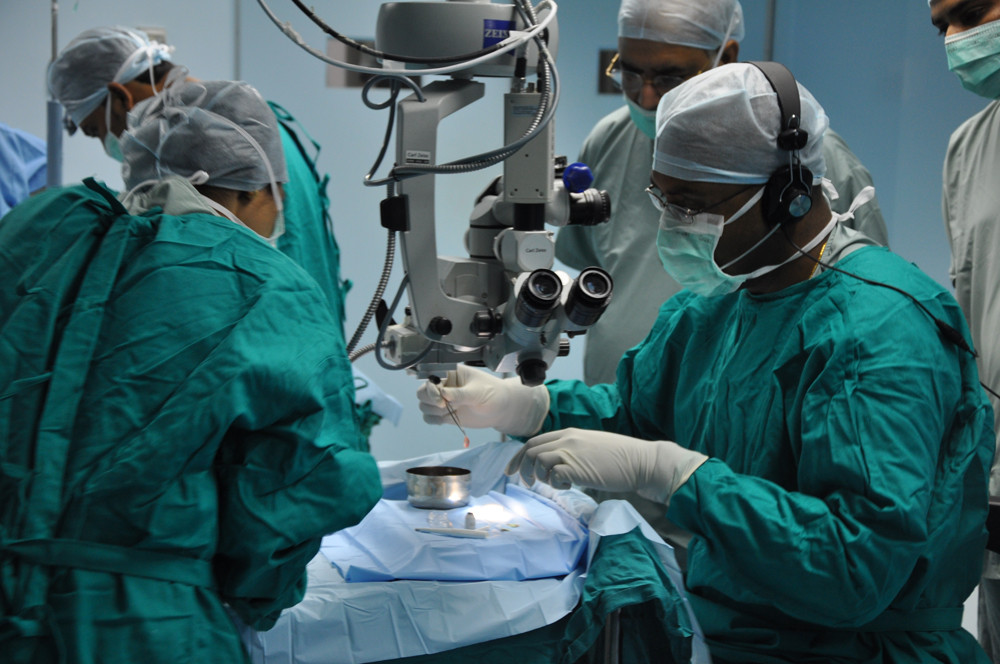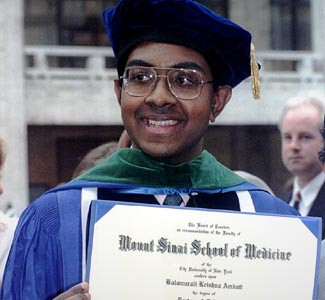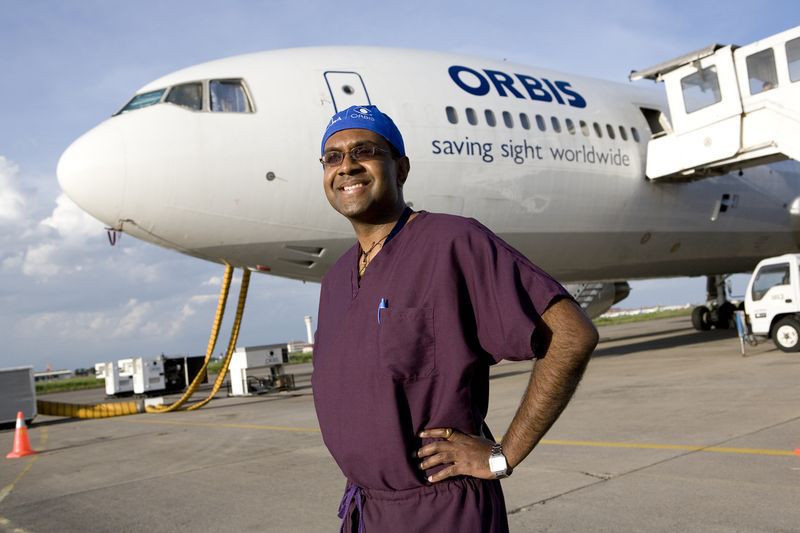In the realm of extraordinary achievements, Dr. Bala Ambati stands as a testament to exceptional intellect and unwavering dedication. This year marks the 20th anniversary of a remarkable milestone in his life: his graduation from medical school and commencement as a practicing physician. While this anniversary might be a routine marker for many doctors, for Dr. Ambati, it carries profound significance. At just 37 years old in 2015, this anniversary highlighted a career already spanning two decades, a career that began when he earned the Guinness World Record as the world’s Youngest Doctor at the age of 17.
Graduating high school at 11, college at 13, and medical school at 17 in 1995, Dr. Ambati’s record remains unchallenged, solidifying his place in history not just for his age but for his continued contributions to medicine, particularly in ophthalmology.
 Dr. Ambati demonstrates the use of the Boston Keratoprosthesis in his clinic.
Dr. Ambati demonstrates the use of the Boston Keratoprosthesis in his clinic.
Dr. Bala Ambati, the youngest doctor in the world, showcases the Boston Keratoprosthesis at his clinic, highlighting his expertise in corneal procedures and patient care.
The distinction of being the world’s youngest doctor has understandably thrust Dr. Ambati into the media spotlight. He’s been lauded as a “whiz kid,” a “boy prodigy,” a “medical academic superman,” and even likened to the fictional child prodigy physician, Doogie Howser. Anecdotes of his early academic prowess, like mastering calculus at age 4, have become part of his public narrative.
However, Dr. Ambati’s persona diverges from the stereotypical image of a child prodigy. Described as calm and humble, he emphasizes gratitude for the opportunities he’s received. For him, the record-breaking medical school graduation is eclipsed by the daily rewards of his profession.
“My biggest accomplishment is taking the patch off the day after surgery every week and seeing people smile,” he shared in an interview with EyeWorld. “That’s what makes me happiest, and that’s the best part of my week.” This sentiment underscores his deep-seated commitment to patient care, a value that anchors his extraordinary journey.
Accelerated Education and Early Passion for Medicine
Dr. Ambati’s journey began when he immigrated to the U.S. from Vellore, India, at the age of three. His family was academically inclined; his father was an engineering professor, and his mother a Tamil linguist and mathematician. With his older brother, Jaya, the Ambati household fostered an environment of intellectual pursuit.
 Dr. Ambati on his medical school graduation day, May 19, 1995—2 months shy of his 18th birthday.
Dr. Ambati on his medical school graduation day, May 19, 1995—2 months shy of his 18th birthday.
Dr. Bala Ambati, recognized as the youngest doctor globally, on his medical school graduation in May 1995, just before turning 18, marking a historic achievement in medical education.
Both brothers demonstrated exceptional academic acceleration. Jaya completed high school in just two years and graduated from Johns Hopkins University at 17, eventually specializing in ophthalmology. Bala surpassed even this rapid pace, completing elementary and middle school each in two years, and high school also in two years, graduating at the remarkable age of 11.
Dr. Ambati credits his family’s support as crucial to his accelerated education. However, he clarifies that his parents were supportive rather than pushy, allowing him to progress at a pace that felt both challenging and comfortable.
“My pace in school was set by what I felt challenged and comfortable with,” he explained. “If I had gone through the normal pathway, I think I would have been very bored and maybe gotten into trouble. I felt I was going at the right pace when it came to math and science and English and history, and doing the advanced subjects that I felt challenged by.” This self-directed approach to learning highlights his innate intellectual drive.
The Ambati brothers’ early interest in medicine manifested in a tangible way in 1989 when they co-authored AIDS: The True Story: A Comprehensive Guide. This book aimed to educate high school and college students about the AIDS epidemic. Published when Bala was only 11 and Jaya 18, the book showcased their maturity and social consciousness.
“We had seen a lot of discrimination against AIDS patients, people’s houses being burned down and run out of town, things like that,” Dr. Ambati recounted. “We wanted to do something that would educate the younger generation … and dispel many of the myths and misconceptions around the disease.” This early endeavor demonstrated their commitment to public health and social responsibility, even before Dr. Ambati became known as the youngest doctor.
Navigating this unconventional educational path wasn’t without hurdles. Dr. Ambati recalls his parents having to advocate intensely with school administrators to permit grade skipping. They faced resistance from principals, superintendents, and even local political figures, who were hesitant to deviate from conventional educational norms. “Administrators in public schools all too often embody inertia,” he noted. “[They were] the main source of resistance, and it was resistance to doing something different, doing something out of the ordinary.”
Despite grade school challenges, college admissions proved more straightforward. Dr. Ambati was accepted into multiple universities and chose New York University. Having already completed college-level courses before the age of ten, he graduated in just two years at 13. Medical school applications, however, presented a new set of obstacles. He faced skepticism and even hostility from interviewers concerned about his age and maturity.
“I think there are understandable concerns about whether someone is mature enough for medical school, but each person matures differently with time,” he reflected. “So I think it’s best to look at each person as an individual and judge them on their own merits, rather than look at them by a particular number.” Despite these reservations, his exceptional qualifications ultimately prevailed.
Dr. Ambati’s perspective on the challenges is remarkably balanced. “I applied to 9 medical schools and only got into 1, but hey, you only need 1, right?” he remarked. “Everything happened the way it was meant to. I got into 1 medical school, and it worked out well, and if I had to do things over again, I’d pretty much do them the same way.” This positive outlook underscores his resilience and acceptance of his unique path.
A Flourishing Career in Medicine and Beyond
Even for the youngest doctor, medical school is a rigorous four-year endeavor. Dr. Ambati attended Mount Sinai School of Medicine, graduating in May 1995, just shy of his 18th birthday. Obtaining his medical license required a special act of the New York State Legislature to permit him to practice medicine at such a young age, another testament to his unprecedented situation.
Since overcoming these initial hurdles, Dr. Ambati has continued to excel. His career trajectory is marked by continuous achievement as a physician, scientist, entrepreneur, author, and volunteer surgeon. He completed residencies in internal medicine and ophthalmology, followed by a cornea fellowship. In 2002, he joined the faculty of the Medical College of Georgia, where he balanced clinical practice, research, and pursued a PhD in cell biology.
In 2006, Dr. Ambati collaborated again with his brother, Jaya, who by then was a retina specialist at the University of Kentucky, to research corneal angiogenesis. Their groundbreaking research identified soluble VEGF receptor-1 as crucial in maintaining corneal clarity, a discovery recognized by Science journal as the Signaling Breakthrough of the Year. This achievement highlights his significant contribution to ophthalmic science beyond his title as the youngest doctor.
 Dr. Ambati volunteers with the ORBIS Flying Eye Hospital and has trained surgeons in Ghana, Malaysia, and India.
Dr. Ambati volunteers with the ORBIS Flying Eye Hospital and has trained surgeons in Ghana, Malaysia, and India.
Dr. Bala Ambati, renowned as the youngest doctor, volunteers with the ORBIS Flying Eye Hospital, demonstrating his commitment to global ophthalmology and surgical training in countries like Ghana, Malaysia, and India.
In 2008, Dr. Ambati joined the Moran Eye Center at the University of Utah, holding professorships in ophthalmology and visual sciences, neurobiology and anatomy, and bioengineering. His pursuit of knowledge and innovation led him to earn an MBA and co-found iVeena, a biotechnology company with his brother. iVeena aims to revolutionize eye care through innovative drugs and devices, including treatments for post-cataract inflammation, glaucoma, and macular degeneration.
Beyond his academic and entrepreneurial pursuits, Dr. Ambati is deeply committed to volunteer work. He dedicates his time to the Orbis Flying Eye Hospital and other organizations, traveling globally to perform surgeries and train other surgeons. His volunteer work reflects his dedication to making quality eye care accessible worldwide.
Looking ahead, Dr. Ambati shows no signs of slowing down. “There’s still so much to do just in ophthalmology alone,” he states. “I love seeing patients and operating and doing research, and I would love to see some of our discoveries in the lab become products that transform practice and improve the way we treat patients. I want to keep doing what I’m doing and keep firing on all cylinders.” His ongoing commitment to innovation, patient care, and global ophthalmology cements his legacy far beyond being just the youngest doctor; he is a pioneering force in his field.
Source (all): Bala Ambati, MD, PhD
Contact information
Ambati: [email protected]
